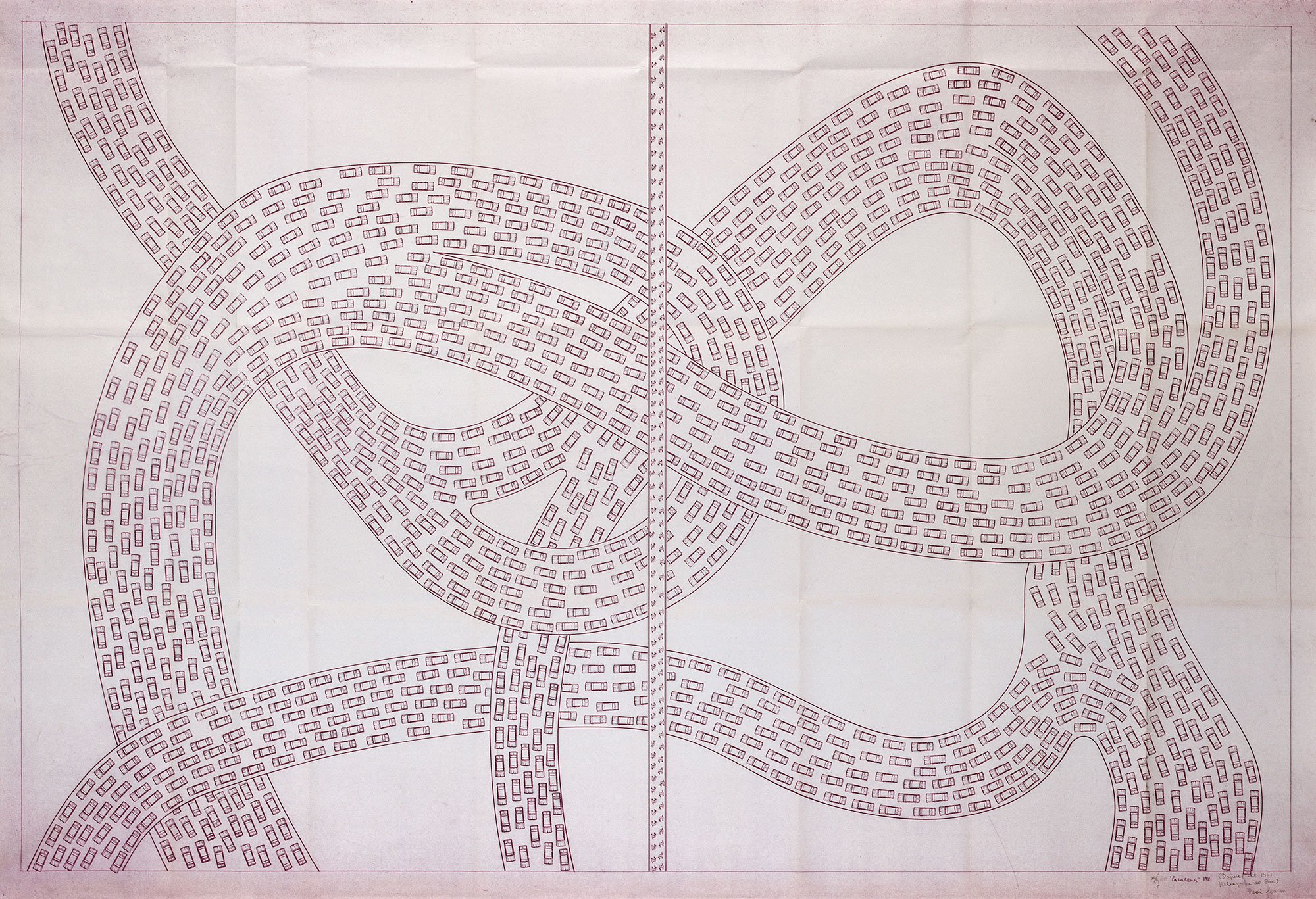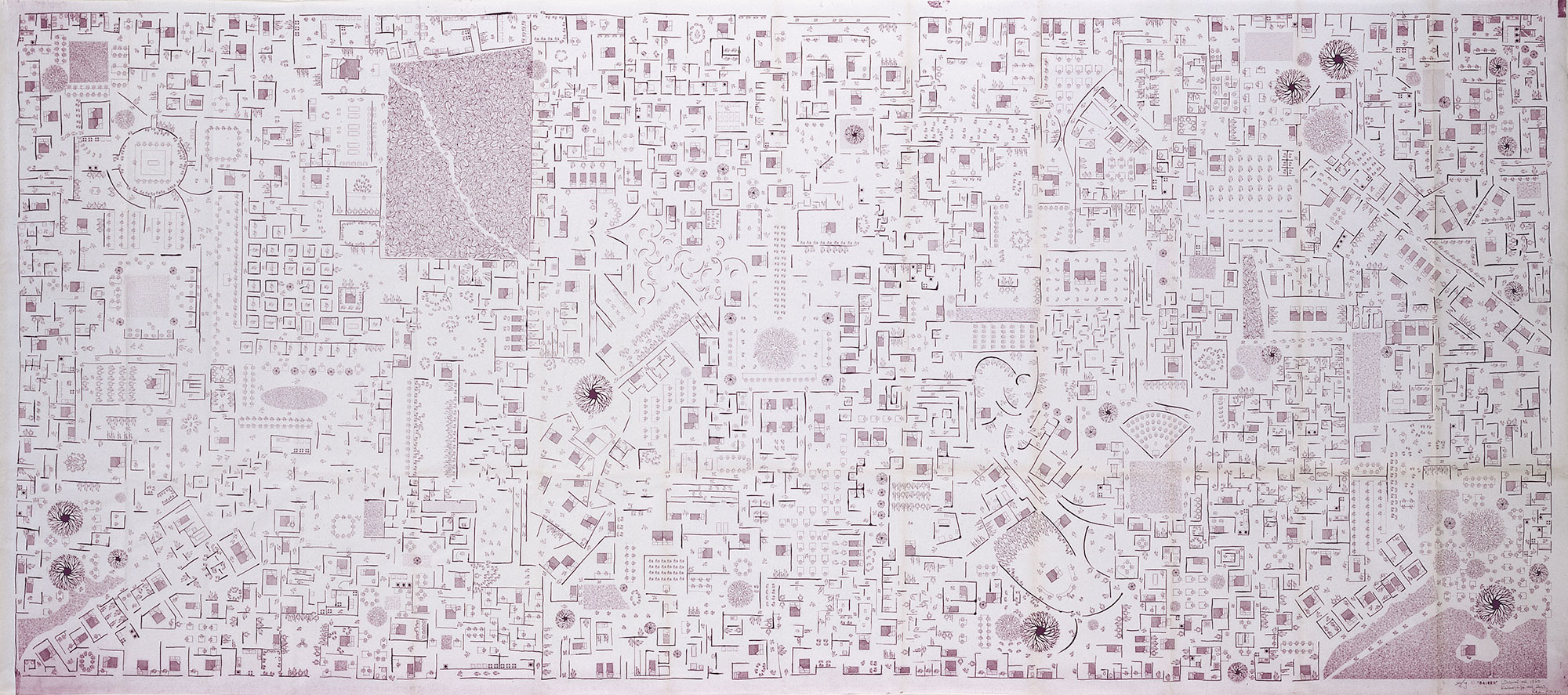The Heloigrafías mix humor with the feeling of oppressiveness. In this sense, if the works do not directly reference the violence that ruled urban life in Argentina, they do manage to condense the feeling of madness, confinement, and asphyxia that dominated public life during those years.
The azure haze that is the dominant tone of León Ferrari’s Heliografías (blueprints) maps the enigmatic territory of this series created by the artist in the first years of his exile in the city of São Paulo. The creator of a body of work as radical as it is fulminating, Ferrari is among the key artists of the 1960s. From the late 1950s, he exhibited his sculptures made of wire, ceramic, wood, and cement, and in 1962 he began the series of drawings that he continued, with interruptions, until his death in 2013. If his drawings establish a line of continuity within his body of work, there are many chapters that define particular series, compact moments in which their development has a beginning and an end that contain a particular and distinct episode. Among these are the drawings that refer to the militarization of civic life, a series of abstract writings that he called Cartas a un general (Letters to a General) and which culminates in a work that was key to the fusion between the artistic and the political avant-gardes of the 1960s: La civilización occidental y cristiana (Western and Christian Civilization, 1965), an assemblage in which he affixed a crucified Christ figure onto a model of a bomber used by the United States Air Force in the Vietnam War. After this work, he abandoned traditional art circuits; he abandoned drawing and the wire sculptures. In November 1976 Ferrari and most of his family left Buenos Aires for an exile that lasted until 1991.
The circumstances were adverse, and he lived with uncertainty and insecurity. Nevertheless, or precisely because of it, after ten years he returned to wire sculpture and drawing. When he arrived in São Paulo, Ferrari joined a group of highly experimental artists, and in that context he took up two new expressions: musical instruments (the berimbaus) that derive from the wire sculptures, and the Heliografías. Changes in an artist’s work are in general linked to technical discoveries. In Ferrari’s case, Letraset architectural symbols—those dry transfer icons that until recently have been used to indicate people, furniture, or vegetation in architectural plans—began to appear in his drawings. The predilection for geometry in these series is not alien to his other skills: Ferrari was an engineer and helped his father with the calculations for the churches he built. Clearly this does not explain the work, as it only gives us a clue leading us to the artist’s choices of expression.

In the case of the Heliografías, these refer, first, to the impact that the vast metropolis of São Paulo produced in him, with its intertwined roads (as in Passarela), and compressed urbanizations (as in Bairro). Ferrari organized these with India ink, collage, and Letraset icons representing cars, men, women, doors, toilets, and beds—all these elements, and the attitude of the people who walk, transit, and sit, animate these jammed spaces where it hardly seems possible to live. Like panoptic complexes, they map impossible and asphyxiating routes, only relieved by the humor that is introduced into situations unregulated by the architecture in which the people live: spaces stuffed with beds and vegetation, labyrinthine and nonfunctional routes, odd communal experiences of multitudes sitting in front of a bed, as if it were teaching a class (Bairro).

Ferrari began to mix Letraset with his drawings in 1979, in a long series in which people and animals coexist with the lines of abstract drawing. In the early 1980s, these took the shape of plans that he made with the blueprint method used to copy architectural plans: he folded them and mailed them to his friends. In this way he inaugurated a new form of mail art, with the work going from envelope- to mural-sized. The images mix humor with the feeling of oppressiveness. In this sense, if the works do not directly reference the violence that ruled urban life in Argentina, they do manage to condense the feeling of madness, confinement, and asphyxia that dominated public life during those years.

In 1982 he showed these works in the Carrillo Gil Museum in Mexico City. In an interview in which he was asked about the frenzied character of these images and how they connected to the occurrences in his country, he stressed the experience he lived in Argentina. “I feel the need to express how terrible that was and still is, but I cannot say I want to do something and then do it, because before, I would have to achieve something with the same force as the horror in Argentina; and if the language does not have the same level of force, it is difficult to reflect that reality. I do not know anything in the expressive realm that has the force of the repression in Argentina.”1 1 León Ferrari, interview with Adriana Malvido, unomásuno, México D.F., April 7, 1982. In this way, these images fuse poetry, lyricism, madness, and oppression in immense mural works that the artist decided to print in infinite editions (in the last editions the series are in fact numbered x / ∞), as a form of assembling and disseminating through the world the urban perceptions that combined the experience of São Paulo and the memories of Buenos Aires.
Andrea Giunta, 2017 (2010) Andrea Giunta is Professor of Latin American Art at the University of Buenos Aires, Argentina. This essay was first published in: Al calor del pensamiento. Works from the Daros Latinamerica Collection, exhibition catalogue, Madrid, Fundación Banco Santander, 2010.
(Translated by Noel Smith)



